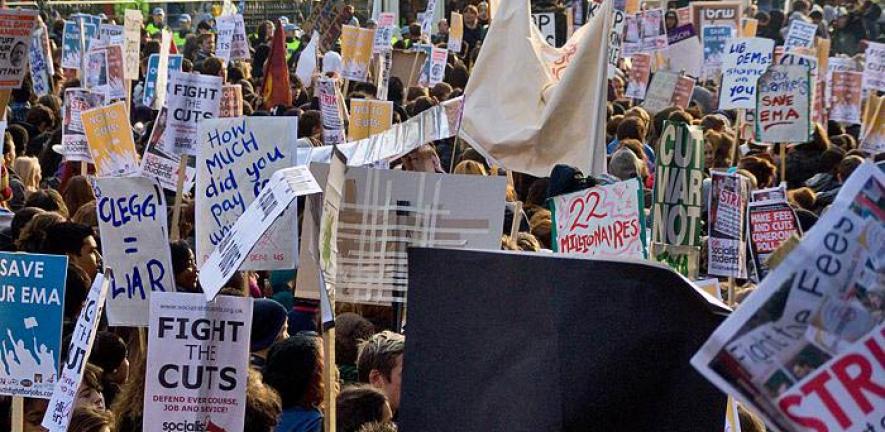
Students ripped up their university exam papers in protest against established authority and in rejection of formal qualifications; a progressive sociologist assigned his students the storming of a public office as field-work; avant-garde writers, street theatre and poets moulded a bohemian sub-culture was dramatically reshaping university life.
Students ripped up their university exam papers in protest against established authority and in rejection of formal qualifications; a progressive sociologist assigned his students the storming of a public office as field-work; avant-garde writers, street theatre and poets moulded a bohemian sub-culture was dramatically reshaping university life.
The 1960s was a period of joy, music and optimism. By the early 1970s, there was a huge change in the economic and educational climate.
David Fowler
This was 1960s Britain, when radical students dramatically tipped the power balance of education. Their movement: bold, polemical and revolutionary, transformed the university system conclusively.
University of Cambridge historian Dr David Fowler is an academic with special interest in youth movements and student protest of the 1960s and ’70s.
He will be discussing student sit-ins, lock-outs and their impact in a talk entitled The Creative Campus on Thursday 20 October, 5.30-6.30pm, at Mill Lane Lecture Rooms as part of Cambridge University’s Festival of Ideas.
The Festival of Ideas is the UK’s only arts, humanities, and social science festival and this year offers over 160 free events to participants of all ages between October 19-30.
Dr Fowler, who teaches in the interdisciplinary Faculty of Human, Social and Political Science, has formerly argued that “The Beatles were capitalists”, stating that a clear distinction should be made between ‘pop culture’ which is media driven, and ‘youth culture’ which he describes as organically driven.
Despite his argument sparking an indignant backlash of musical patriotism, it cannot be denied that a dark chasm existed between the rock ‘n’ roll life of The Beatles and the Rolling Stones and their fainting teenage fans.
In his new book, The Creative Campus: Student Protest and the Remaking of British Culture in the Global 1960s, Fowler seeks to re-define the interpretation of ‘Youth Culture’ during the 1960s and 1970s.
Not largely documented in historical literature, Fowler uses sources uncovered at British universities such as Cambridge, Oxford, Essex, York and Queen’s Belfast in Northern Ireland. His book is an analysis of the motivations, methods and consequences of both prominent and underground student movements. The research throws light on a fascinating topic. Ideas disseminated by students during this period completely transformed the education system, posing challenging questions examining the interaction between youth and culture. These questions still hold huge importance and relevance today, as students are back in the spotlight of the media and universities come under further intense scrutiny.
Post-war Britain saw a huge increase in the number of young people going to university, doubling during the 1960s alone. This new cohort included more women, working-class and lower middle-class students than ever before, becoming the active ingredient in this new recipe for change. ‘Swinging London’ had put on its dancing shoes, allowing liberation in the workplace, personal relationships and British culture.
Fowler said: “The 1960s was a period of joy, music and optimism. By the early 1970s, there was a huge change in the economic and educational climate, culminating in the Oxford and Cambridge protests which erupted in 1972-4. Were the students reacting to political events? Or were they forming a cultural movement bigger than their own focus?”
This generation of university students took on the challenge of a complete re-invention of the education system and, according to Fowler, had “clear, concrete, tangible educational goals”. Feeling increasingly constrained by stuffy traditional subjects in a rapidly evolving world, students were keen to explore cutting-edge areas of research.
They championed the study of subjects such as sociology, psychology and development studies, among many others. He added: “There was huge demand for a different approach – it really was history from below. Students wanted to study the politics of Latin America, radical political movements and the lives and thought of revolutionary leaders such as Che Guevara, alongside the Henrician Reformation. This imaginative, interdisciplinary engagement was completely unheard of, especially in Oxford and Cambridge.”
The pressure for a new curriculum was coupled with demands for a new type of university to house it: the campus. Visionary students dreamed of creating a new physical and intellectual community to cater for their progressive philosophy. A campus university, built on rural greenfield sites outside towns such as York, Warwick, Sussex and Leicester, appealed to their ideas of an educational and enriching sanctuary. Everything that a modern student may desire was available on campus, from everyday amenities to birth control to chaplaincy. Fowler notes that iconic architectural additions, such as the man-made lake on York University campus, are clear indications of the students’ grandiose plans for a utopian learning experience.
The Free University Movement, started by students at King’s College Cambridge, was at the forefront of cultural change. Consisting of young students from all socio-economic backgrounds, its members included Guardian journalist Simon Hoggart, and historians Simon Schama, David Cressy and the late Roy Porter.
“King’s College especially was a laboratory for creating a new culture which included both students and workers. It was not socialist, but anti-establishment, taking the monopoly of culture away from the high-brow, middle-aged, metropolitan establishment,” Fowler explained.
The movement was apolitical and egalitarian, and its aims were to cultivate a national environment of mutual learning between teachers and pupils. The first classes were held at the ‘Arts Lab’ on Mill Road, where teaching consisted of discussions, seminars, talks and film showings with members of the public invited to participate. Fowler claims that “Despite being run by an intellectual elite, the movement itself was far from elitist”; it represented a fervent attempt to overcome the problems of ‘Town and Gown’ which had metaphorically separated residents and students of Cambridge for centuries.
Most importantly, Fowler underlines that the students were an “iconoclastic generation”. Articulate and outspoken, they accompanied their struggle with the publishing of books and newspapers, and regular appearances in the media. The universities became centres to nurture this ambitious social and political change with peaceful and intelligent action. With this in mind, it is not surprising that Fowler remains unsympathetic to the November 2010 student protests; the crimes committed by Charlie Gilmour and Edward Wollard only demonstrate a lack of creativity, imagination and true egalitarian objective when compared with the student movement of the 1960s.
Fowler worries that contemporary student radicalism lacks real ideological depth. He points to the closure of Grammar schools under the Labour government in the late-1970s (he attended one of the last surviving state grammar schools, Nunthorpe, in York), which he argues significantly reduced the number of working-class and lower middle-class students.
He added: “Many working class students became revolutionary spirits and iconoclasts of cultural movements of the 1960s. The most creative of these students were Grammar school educated, and affected social and political movements outside of the education sector. Today, universities shamefully lack this diversity in the student body, which can only serve as a lesson to education policy makers.”
Dr David Fowler will be speaking on Thursday 20 October, 5.30-6.30pm at Mill Lane Lecture Rooms. Please visit /festivalofideas/ or phone 01223 766766.
This work is licensed under a Creative Commons Licence. If you use this content on your site please link back to this page.





